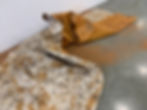

Sustain(ability) & the Art Studio
Online Course
This course prepares artists and art educators to develop ways of thinking about sustainability in their practice, both conceptually and physically. Participants will learn how to wildcraft art materials, a practice that requires one to deepen their relationship with land, creativity, and self. We will also think critically about how one's community and ecosystem are vital allies in a time of socio-ecological destabilization.
The first half of the course includes lectures, guest artist talks, resource offerings, and group discussions, as we explore the implications of a bioregional perspective and investigate the function of art today. In the second half of the course, each student will work on their own project, informed by course content. They will receive feedback from Anna and the class before a final class presentation, open to the public.
Course content includes: lectures, readings, resources, group discussions, guest artist talks, and project development support.
This course has had a substantial impact on my art practice! Anna’s warm informed teaching style modeled and invited deep reflection about sustainability in our work as artists, particularly our choice of materials and how we interact with the world. Anna created a tender encouraging space for individual exploration and group sharing. I researched the history of carbon-based pigments in art, expanded on wildcrafting my own ink and paint using local wildfire charcoal and acorns, contemplated how I balance solitude with community engagement, and investigated how I collaborate with other life forms through the concept of interbeing. Our course reawakened some of my earliest inspirations and has brought that awareness into my present project with more clarity. I continue to find inspiration and motivation from all that was shared by Anna and the other participants!
Andie Thrams, 2025, andiethrams.com
Historical Context


Ecological Frameworks


Processes



Building Relationships



Student Work
Over the last 4 years, I have been teaching Sustain(ability) & the Art Studio biannually through ecoartspace, an online platform for artists addressing environmental issues. I have worked with 100+ participants from over 12 countries. In each course, I invite 2-3 guest artists to speak about their unique practice, cultural background, and/or way of thinking, so as to diversify the course content. By the end of course, each of the students create a project in their bioregion, engaging their own community and ecosystems.




"Ko Au te Whenua: Material Considerations in a Painting Practice" by Helen Harvey
"Ko au te whenua translates to “I am the land”, from the Māori saying “I am the land and the land is me”. This research is about my ancestral and material connection to the Earth. Making paint with earth pigments, plant materials, and non-plastic binders like rabbit skin glue helps me to connect to the place where I live in New Zealand, and to live in right relationship with the natural world."
IG: @helenharveyartist




SUSAN SNIPES
“I committed to a more sustainable art practice with a specific focus on materials in Autumn of 2021. I have collected, catalogued and created my own materials in the Cleveland area for six months. Materials include acorn ink, walnut ink, mineral pigments, beeswax crayons, and charcoal. The shift in my attention enabled me discover treasures like beautiful ochre rocks on my walk or receive black walnuts from friends. I’m grateful to Mother Earth for placing them in my path. Making these materials has deepened my studio practice.”
www.Susansnipes.com
IG: @susansnipesart



Casein paint and discarded threads on wood panel.

LOTTE GEODE
“During the Covid quarantine I became conscious of the harmful impact I was making with my art on the environment. I switched from acrylic paints and cheaply mass-produced canvases to all natural paints on natural substrates. I am currently experimenting with different natural paints and eco-friendly substrates. I am making my own paper from my kids daily-discarded math worksheets and I use raw organic cotton canvas hung and sticks I find in the forest. I paint on these with casein paints (a milk product based paint), tempera paints (egg yolk plus natural pigment) and walnut oil with natural pigments."




NICOLE GARDINI
Nicole organized a community art making event in a small village in Goiás, Brazil. The goal was to bring the community together and embrace their local knowledge of art, food and medicine making processes, learning from and engaging with the local cerrado.
IG: @nicoletakasse




KARLA ZAMARRIPA
As an aspiring art educator, Karla created her own curriculum and facilitated her own class around topics discussed in the course relating to sustainability, interconnectedness, and community resilience. Inspired by traditional approaches to art-making using found objects, Karla embraced her Mexican heritage, creating folk art from discarded materials.
IG: @hechaxkarlillagalletilla




LIZZY STORM
My personal sustainability goals revolve around reconnecting with our natural resources: earth, air, water, and living resources such as plants, animals, and fungi. The idea of waste is foreign to my core values of mutual respect and thoughtfulness for others and the environment. I want to be able to see the whole stream of materials in my practice as useful, and to connect with community through these shared practices of cyclical being.
Ig: @lizzystorm
@lizzystormstudiofuel
Course Content


